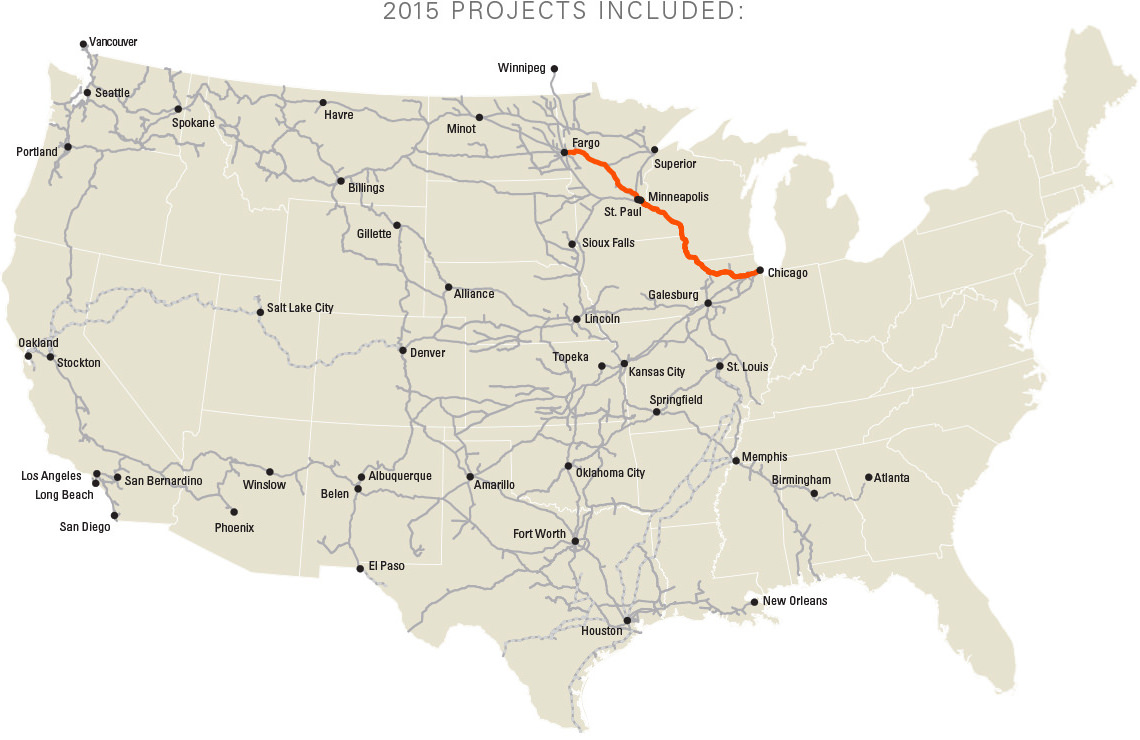




A Message from Carl Ice
I have always said that BNSF is a great company made up of great people, and I thank every one of our hard-working, dedicated team of employees for helping BNSF continue to play a vital role in supporting and strengthening our nation’s economy. We are proud to be a key link in the North American supply chain. It is a role that all of us at BNSF Railway take very seriously.
There is nothing more important to BNSF than operating a safe and secure railroad. In safety, we continued to reduce the number of injuries and improved our injury frequency for the sixth straight year. Unfortunately, while overall injuries have declined, the severity of injuries – or time away from work – has risen. We are continuing our strong safety focus and remain confident that we have the right processes in place to achieve our vision of an injury-free workplace.
After a challenging 2014, our tremendous strides in service reflect the hard work of employees across our network as well as our record capital investment of more than $11 billion over the past two years. Our service performance was strong in 2015, with an average velocity about 13 percent higher than 2014, and a return to 2013 levels.
Contributing to these improvements are more than 880 new miles of track being placed under high-efficiency Centralized Traffic Control and more than 100 new miles of double track in 2015.
Going into 2016, we now have two main lines on more than 99 percent of our Southern Transcon route between Southern California and Chicago and on nearly 50 percent of our Northern Corridor route between the Pacific Northwest and Chicago.
Our 2015 volumes were flat compared to 2014. However, we still moved a significant amount of freight last year. We were the only railroad to handle more than 200,000 units in a week – and we did it 25 times. During the second half of the year, the U.S. economy felt the impact of low oil and natural gas prices and a strong dollar on exports. Volumes began to decline more quickly, particularly in coal, energy and certain industrial product sectors. The current freight environment has significant challenges, and there is no doubt 2016 will be a difficult year.
We view these challenges somberly, but we know we will get through it. Economic cycles will continue to change over time, but we remain confident about our future. Our significant investments in our network have enabled us to increase capacity and positioned us to handle greater volume demands in the years ahead. When it comes to serving our customers and our communities who keep our economy moving, BNSF has the capacity to go further.
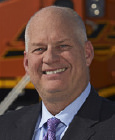
Carl Ice
President and Chief Executive Officer
BNSF by the Numbers
Did You Know?
BNSF’s 32,500-mile network is more than 15 times longer than the driving distance between the Willis Tower in Chicago and the Space Needle in Seattle.
Safety
BNSF’s safety vision is to operate free of accidents and injuries
– preventing them in the first place through training, technology and safety programs.
In 2015, we continued the implementation of our Approaching Others About Safety initiative and enhanced safety in our communities with measures including the training of first responders across our network.
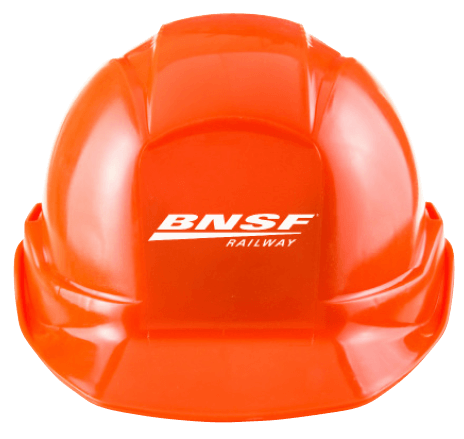
Employee Training
BNSF employees are trained on a comprehensive set of safety rules and practices, including federal regulations, rail industry recommendations and BNSF-specific initiatives. Most of our formal training is conducted at the BNSF Technical Training Center (TTC) in Overland Park, Kansas. The TTC develops relevant course curricula and utilizes simulation and representative lab equipment that represents major equipment types including locomotive, crane and grade-crossing simulators. TTC instructors train some 9,000 BNSF team members and another 500 rail industry employees each year.
Approaching Others About Safety
Our Approaching Others About Safety initiative is focused on addressing the exposures that result in 97 percent of the fatalities and serious injuries in our industry. In 2015, more than 35,000 team members received training in this initiative, learning how to be confident and effective when speaking to one another about safety. In thousands of conversations every day, BNSF team members are looking for ways to minimize risk and eliminate injuries for themselves and their work teams.
A BNSF job safety briefing underway near La Crosse, Wisconsin.

A BNSF job safety briefing underway near La Crosse, Wisconsin.
Growing Safer
As a whole, the U.S. rail industry is safe and continues to grow safer; BNSF is a leader in this crucial area. For our sixth straight year, we have achieved year-over-year improvement in injury reduction. In 2015, our injury frequency declined by four percent. However, we did see an increase in our injury severity ratio and recognize that we must continue our strong safety focus to reduce and eliminate risk. We are confident we have the right processes in place to achieve our vision of an injury-free workplace.
Training First Responders
BNSF has long played an active role in our communities, training emergency hazmat responders to be ready to act effectively in the unlikely event of an emergency involving our railroad. In 2015, we helped train more than 10,000 first responders across our network. BNSF and railroad industry partners provide such training through the Transportation Community Awareness and Emergency Response (TRANSCAER) program. BNSF has an extensive system of emergency responders covering our 32,500-mile network who are trained to respond to everything from small non-accident releases to major releases. Additionally, we have strategically placed response equipment across the network.
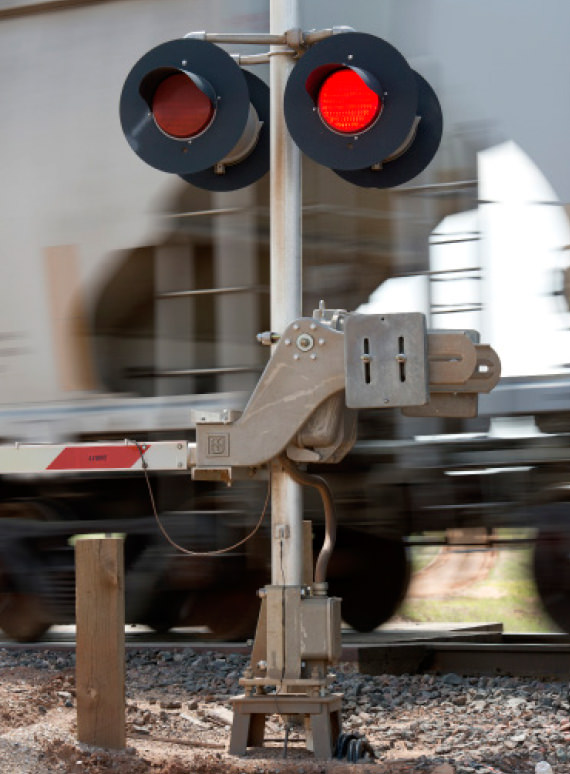
Grade Crossings
BNSF has one of the industry’s lowest highway-railroad grade-crossing collision rates; since 1995, that rate has been reduced by 71 percent. BNSF invests an average of $117 million a year on grade-crossing maintenance, improvement and safety programs. One of the best ways to address grade-crossing safety is to reduce the number of at-grade crossings. Since 2000, by working with communities and landowners, we have been able to close more than 6,000 grade crossings. In 2015, in communities across our network, BNSF participated in International Level Crossing Awareness Day activities, promoting the See Tracks? Think Train message.

Network and Equipment Inspections
To ensure the safety of BNSF track and bridges, BNSF makes every effort to ensure every mile of its 32,500-mile network is in good repair. Wayside detectors spread across the network collect data 24/7 year-round, alerting BNSF to potential safety issues such as high-impact wheels, overheated bearings and damaged/worn components. Key routes are inspected twice as frequently as required by the Federal Railroad Administration. Our busiest mainline routes are often inspected even more frequently, and our bridge inspectors conducted more than 60,000 bridge inspections in 2015. From ground-penetrating radar to unmanned aerial vehicles and bridge inspection vehicles, BNSF deploys a range of technology to keep our tracks and bridges reliable and in safe operating order.
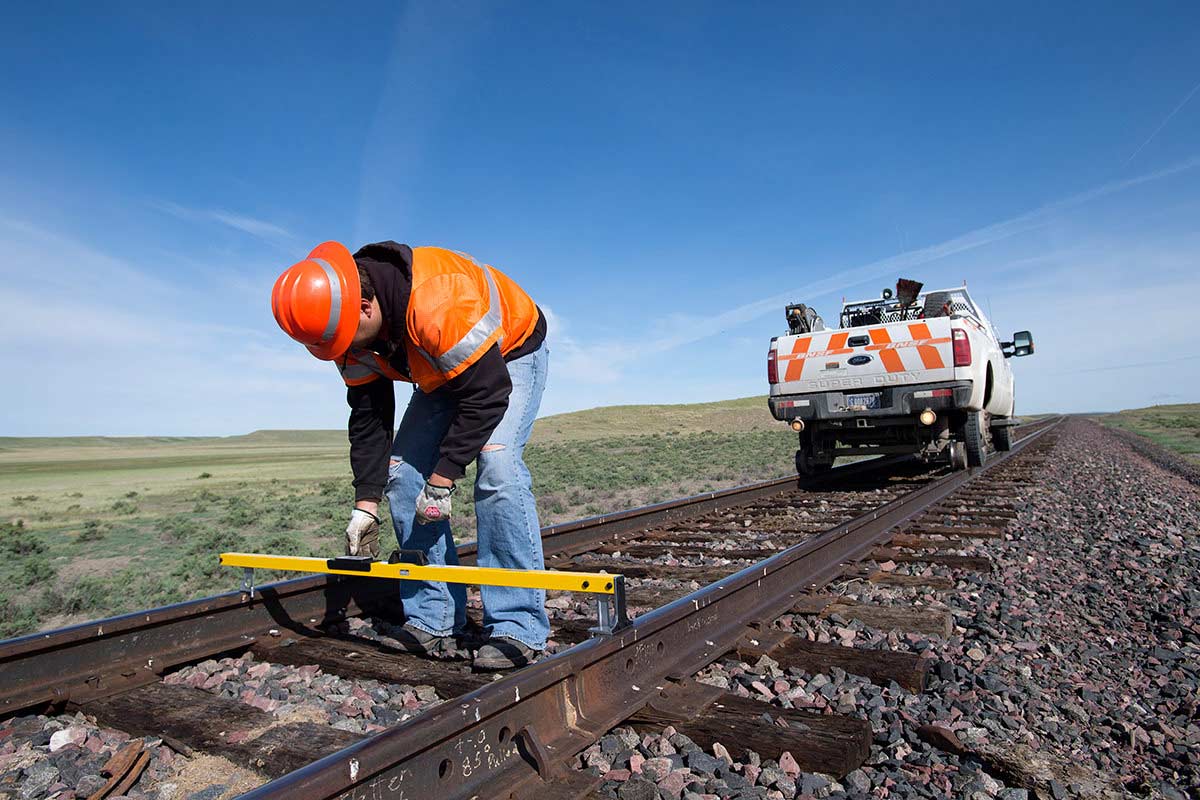
Did You Know?
Every day, BNSF’s network of wayside detectors takes 55 million readings. That’s about 3.5 times the number of books at the Library of Congress.
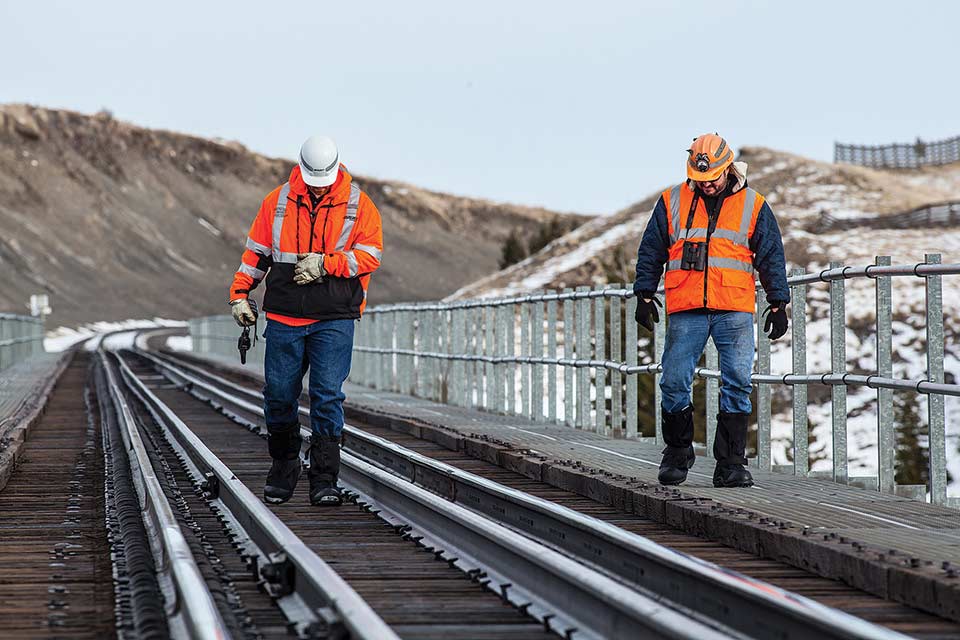
Did You Know?
Every day, BNSF’s network of wayside detectors takes 55 million readings. That’s about 3.5 times the number of books at the Library of Congress.
Service
In 2015, BNSF served shippers of consumer products, industrial products, agricultural products and coal, providing an essential link in the national supply chain and moving the U.S. economy forward.
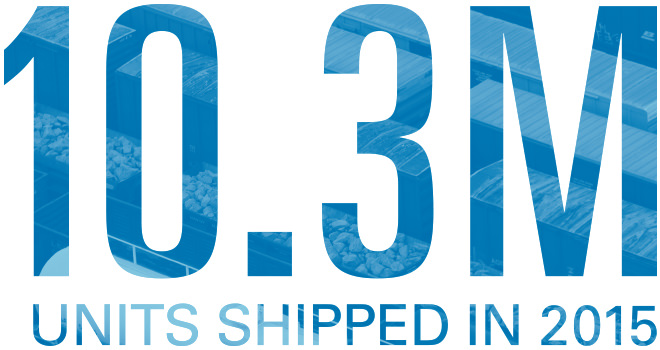
Did You Know?
In 2015, BNSF hauled approximately 5 million intermodal units. If all of that were somehow carried on one train, in double-stacked 53-foot containers, the train would be more than 25,000 miles long!
What We Carried in 2015
(Thousands of units, with year-over-year change)
CONSUMER PRODUCTS
COAL
INDUSTRIAL PRODUCTS
AGRICULTURAL PRODUCTS
2015 Capital Investments
| 51% | Core Network and Related Assets |
|---|---|
| 24% | Locomotives, Freight Cars and Other Equipment |
| 22% | Expansion and Efficiency |
| 3% | Positive Train Control |
Results of Investments
4
New Sidings
and extended sidings.
13
Extended Sidings
260
Bridge Projects
880+
New Miles under
Centralized Traffic Control
100+
Miles of Double Track Added
double track.
5,300
Miles of High-Speed Rail Surfacing
3.5M
Ties Replaced
Did You Know?
The number of ties we replaced in 2015 is greater than the combined populations of our major hub city Chicago, and our headquarters city, Fort Worth.
Enhancing the Northern Corridor
In 2015, BNSF continued transforming our Northern Corridor between the Pacific Northwest and Chicago into a rail superhighway, just as we’ve done with our Southern Transcon route between Southern California and Chicago.
Since 2013, BNSF has invested more than $3.5 billion to maintain and expand the Northern Corridor. In 2014, we focused on capacity-enhancing projects west of Fargo. In 2015, our focus has been on expansion efforts east, along the heavily traveled route from Fargo to Chicago.
Did You Know?
In 2015, we added more than 100 miles of double track to our network. That’s like laying down the length of more than 1,460 football fields of track.
New Northern Corridor Intermodal Schedules
A tangible result of our Northern Corridor investments: the new service schedules for domestic intermodal customers launched in 2015.
- New service features include the only expedited intermodal service to and from Seattle.
- The Expedited North Line service offers seven-days-a-week service for westbound traffic and six-days-a-week service for eastbound traffic.
Did You Know?
Only 7 miles remain to be double tracked on our Southern Transcon route between Southern California and Chicago; that’s well below the average American’s daily commute to work of 12.6 miles.
Logistics Center at Sweetwater
Completed late in 2014, the BNSF Sweetwater Logistics Center quickly established itself as a major resource for Permian Basin shippers in 2015. The center supports shippers of sand, pipe, aggregates, agricultural commodities and more. The revitalized 75-acre facility includes an expandable BNSF switch yard and 40,000 feet of new track.
Improved Automotive Capabilities
To better serve our automotive industry customers, BNSF doubled the size of our automotive switching facility at the Argentine Yard in Kansas City. Leveraging Kansas City’s strategically central location, the expanded switching yard now functions as our primary automotive switching facility, handling approximately 50 percent of our rail automotive traffic. Railcars are now consolidated from multiple points, enabling us to run dedicated automotive trains outbound from Kansas City. Efficiently handling larger volumes also allows us to reduce dwell times and improve overall velocity – so new cars arrive to dealerships more quickly.
Did You Know?
A new car or truck is loaded onto or unloaded from a BNSF automotive train approximately every 11 seconds. That amounts to more than 2.8 million vehicles, or about 1 out of every 6 cars and trucks sold in North America.
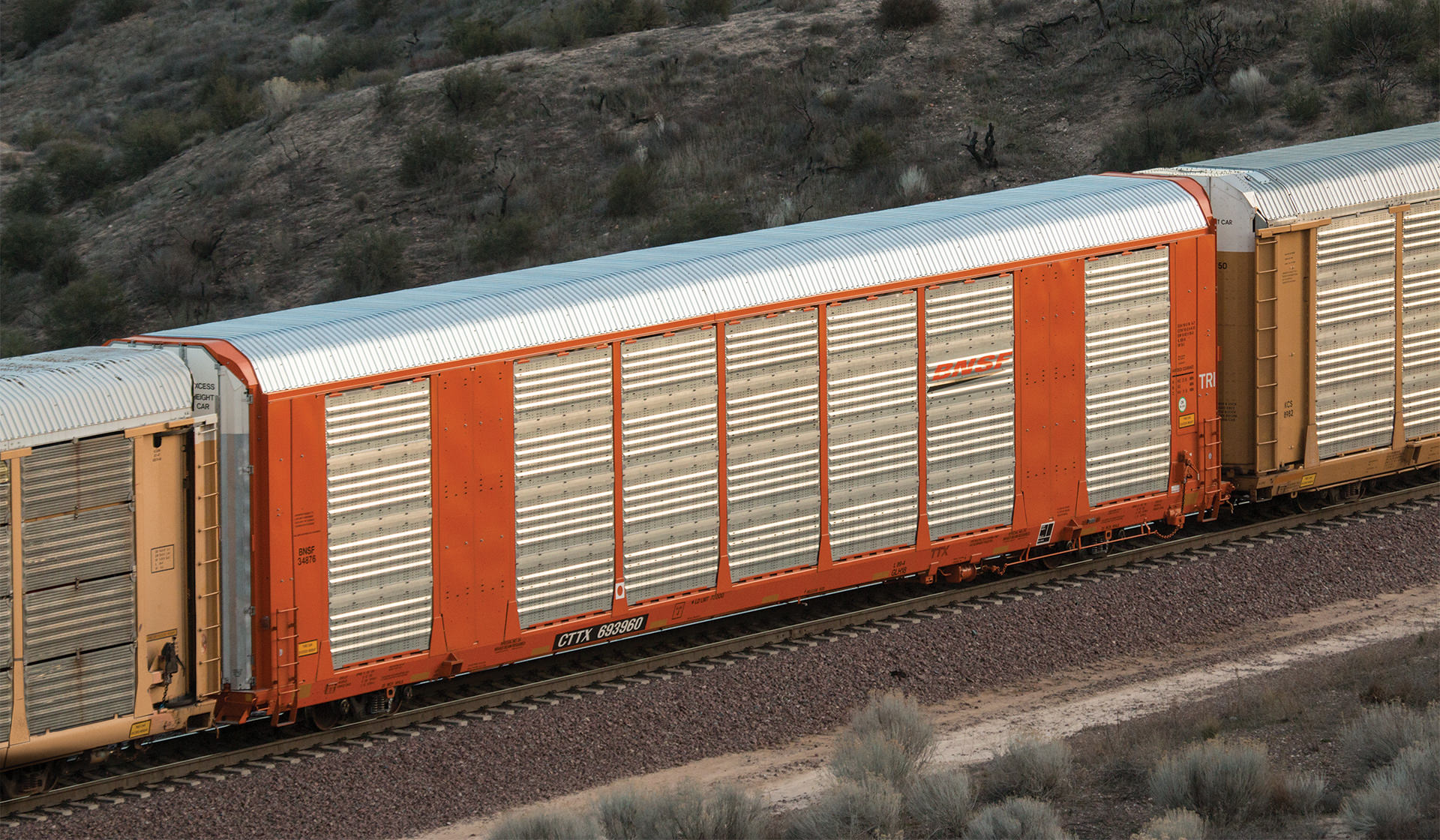

ENVIRONMENT
Rail is by far the most environmentally friendly mode of land freight transportation.
At BNSF, we believe it is good business to reduce our impact on the planet and to contribute to the long-term sustainability of every community we serve.
BNSF’s environmental performance includes maintaining the industry’s newest and cleanest-burning fleet of locomotives.
Customer Carbon Reduction
By shipping with BNSF intermodal instead of using entirely over-the-road solutions, BNSF customers reduced their total carbon emissions by 34 million metric tons in 2015.
This carbon savings is equivalent to:
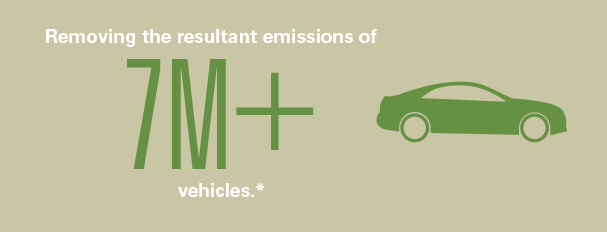
OR
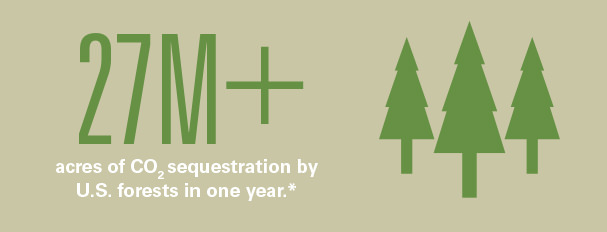
*Source: U.S. Environmental Protection Agency’s Clean Energy website.
A BNSF train passes through northwestern Oklahoma.
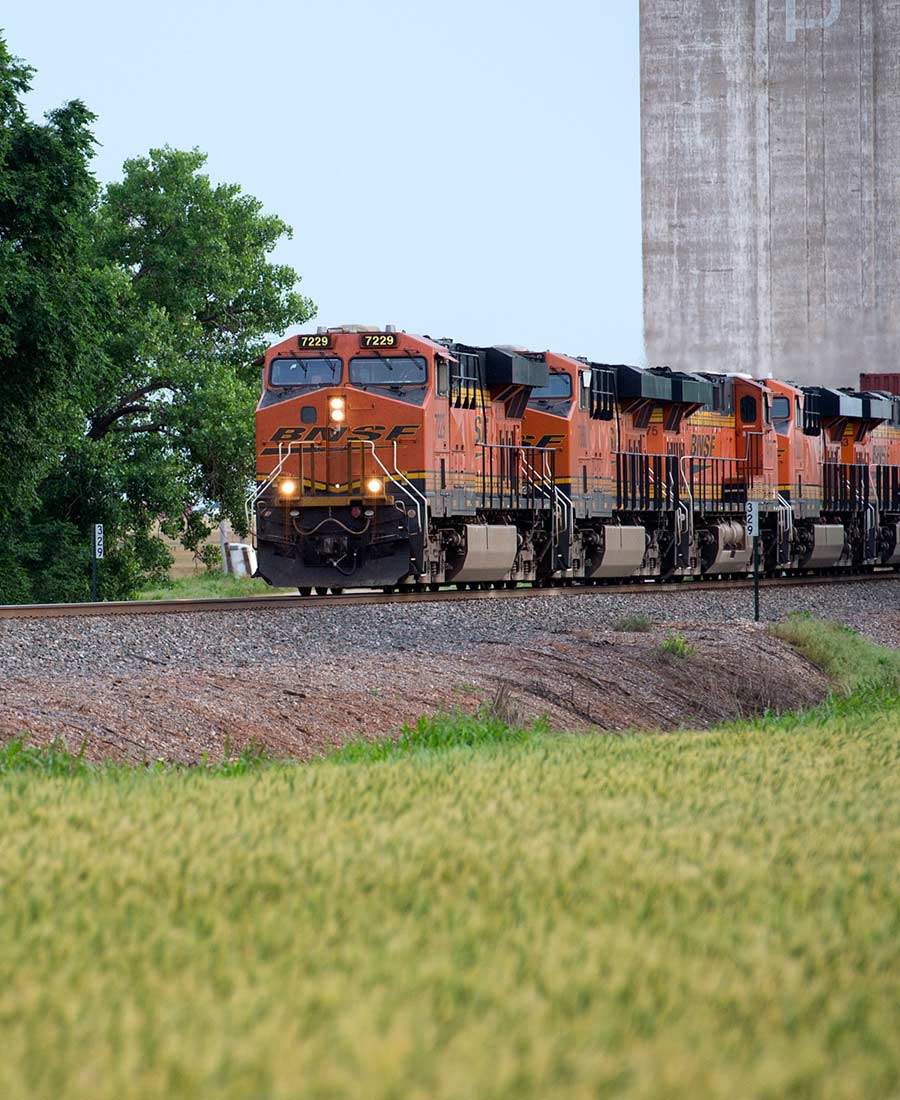
Reducing Emissions
More than 40 percent of BNSF’s locomotive fleet has been upgraded to more energy-efficient technologies in the last ten years, helping us make great strides in increasing fuel efficiency and decreasing CO2 and particulate emissions.
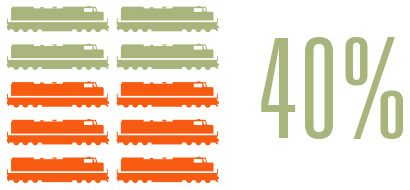
Intermodal Conversions
Motor-carrier partners are realizing the cost and environmental advantages of allowing BNSF to handle long-haul distances, while trucks handle local pickups and deliveries to and from intermodal facilities. Such intermodal shipments allow motor carriers to reduce fuel costs, deal with driver shortages and handle growing demand, while also reducing carbon emissions and relieving congestion and wear and tear on U.S. highways.

Wide-span cranes in operation at the BNSF Memphis Intermodal Facility.
Did You Know?
BNSF cranes lift the equivalent of 15 trailers or containers a minute, every minute – one more than the number of breaths that the average human takes every minute.
Recycling
BNSF further reduces our environmental impact by engaging in significant recycling.
In 2015, BNSF recycled:
Legacy Sites
BNSF is meeting the challenge of addressing environmental impacts at legacy sites where rail operations have been conducted for up to a century or more. In the past ten years, BNSF has invested approximately $600 million on remediation efforts throughout our network, and has completed work on and rehabilitated approximately 260 sites.
Did You Know?
A single double-stack intermodal train removes more than 280 freight trucks from the highway – the equivalent of 1,100 cars.
Did You Know?
A single double-stack intermodal train removes more than 280 freight trucks from the highway – the equivalent of 1,100 cars.
Employees
At BNSF, our people drive our business forward, and we empower them to lead the way and define our journey.
In 2015, BNSF received recognition for our diversity, our welcoming of veterans and our training excellence.
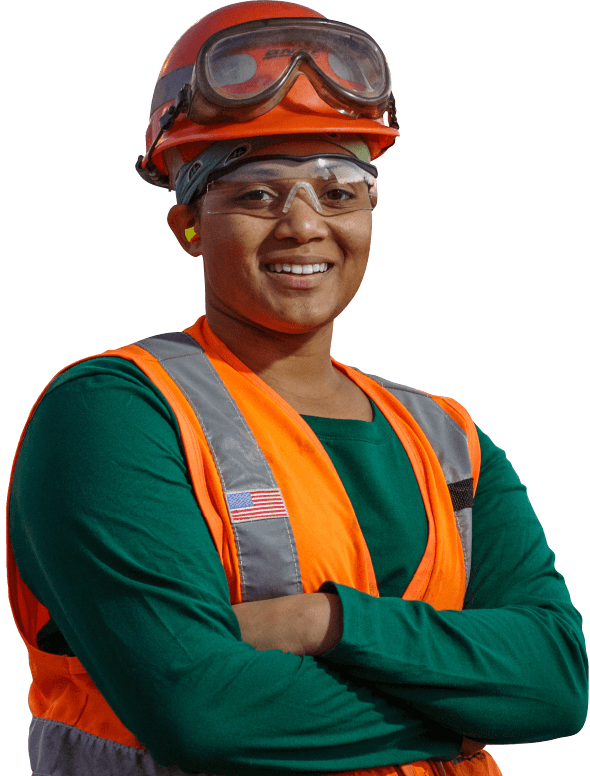
Diversity
The people of BNSF reflect our nation’s diversity. Company wide, 31 percent of our most recently added teammates are minorities and women. In 2015, we were named, for the ninth consecutive year, a “Best Diversity Company” by the readers of Diversity/Careers in Engineering & Information Technology. BNSF participates in scholarship programs that benefit minority students, and the BNSF Railway Foundation supports colleges, universities and other organizations, including the American Indian Science and Engineering Society and the United Negro College Fund.
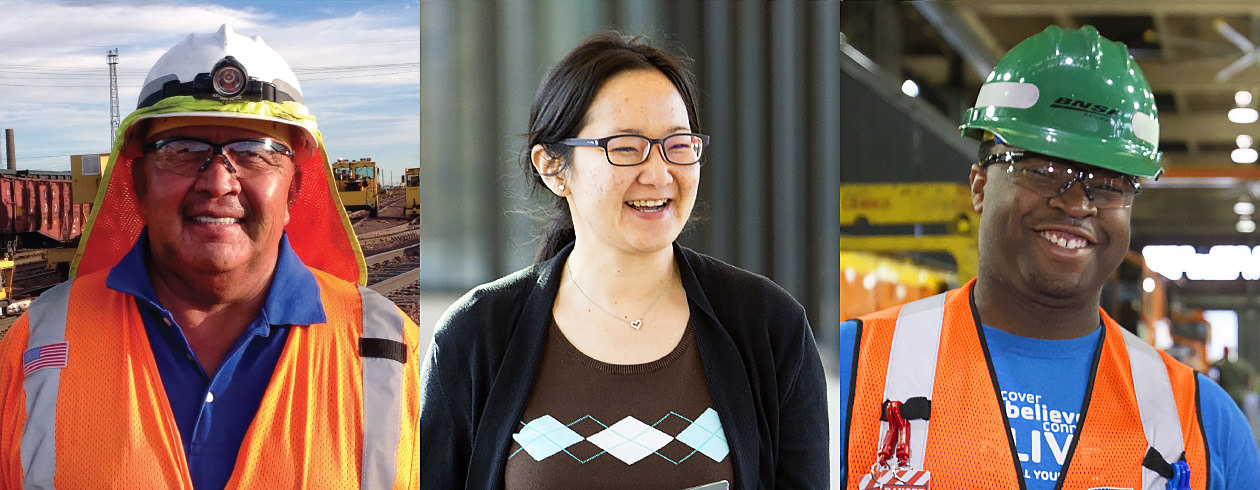


Military Veteran Destination
We know from experience that our company benefits by hiring men and women who have served our country. Veterans possess the experience, determination and dependability that make them a natural fit for BNSF. Veterans quickly assimilate to the unique challenges of the railroad, such as tough weather and 24/7 year-round operations, and are accustomed to working under demanding conditions in a safety-sensitive environment. BNSF employs more than 7,500 self-declared veterans and, in 2015, approximately 28 percent of all newly hired employees were veterans. For the eighth consecutive year, BNSF received a most Valuable Employer for Military Award from CivilianJobs.com in 2015.
In addition, BNSF employs and supports reservists, including enabling needed time off for training and deployment. And we provide make-whole pay for our employees who are called out on deployments.
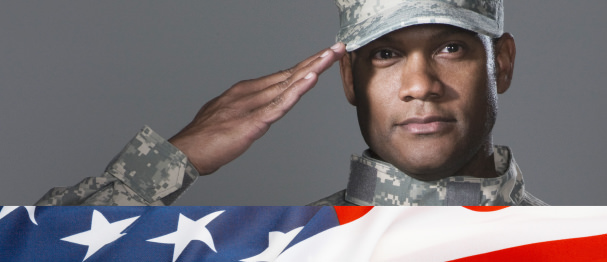
Training Excellence
BNSF sets high standards for performance and makes development a priority for every employee. We view our people as a key competitive advantage, and our training solutions, both technical and leadership, are integral to sustaining our business results. We offer targeted, role-based training and on-boarding to every employee, emphasizing safety, technical expertise and leadership. Employees have the opportunity to learn on best-in-class simulators, from industry experts, through structured on-the-job rotations, from their peers and from our leaders. In 2015, BNSF was recognized as #29 in Training Magazine’s Training Top 125, making it the second consecutive year in the top 125. For the award, companies were evaluated on factors including financial investment in employee training/on-boarding, the extent of innovation used to solve training needs, and linkage between training and business results. BNSF also won an ATD Best Award from the Association for Talent Development, ranking as the #2 overall company.
Career Longevity
From veterans starting a second career to college graduates looking for their first job, BNSF attracts, develops and retains top talent for long-term careers. We have a variety of programs to support this strategic initiative including our Management Trainee program, Experienced First Line Supervisor program and our First Line Supervisor program.
Additional career development offerings include formalized feedback and coaching, mentoring programs, tuition reimbursement and experiential job-rotation assignments. Over 90 percent of our leadership positions are filled with internal candidates.
BNSF team members at BNSF corporate headquarters in Fort Worth, Texas.

BNSF team members at BNSF corporate headquarters in Fort Worth, Texas.
Community
The people of BNSF are active, caring members of the places we call home, and BNSF is proud to support many national and local nonprofit organizations that help make communities stronger.
In 2015, BNSF community activities included special train rides for military personnel, first responders, and children and their families.
The children of first responders in San Bernardino, California, enjoy a special day that includes a ride on the BNSF First Responder Express.
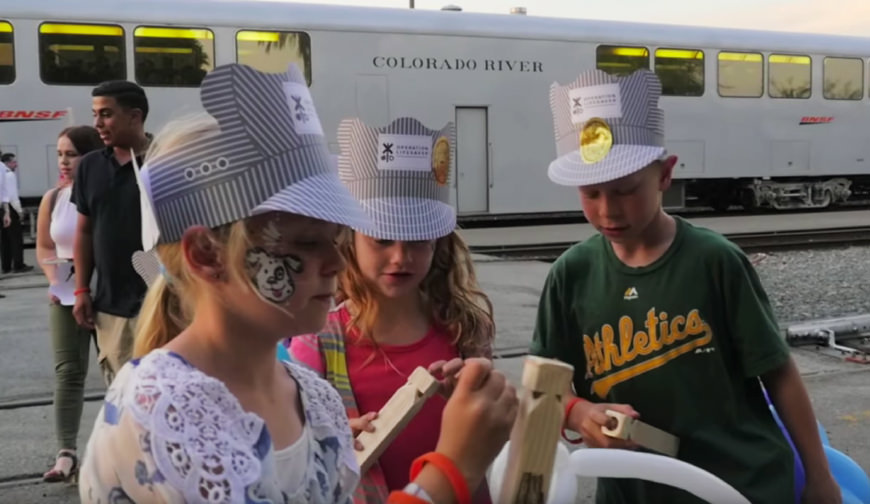
The children of first responders in San Bernardino, California, enjoy a special day that includes a ride on the BNSF First Responder Express.
Phoenix Children’s Train
For 16 years, BNSF Railway’s Southwest Division has sponsored a special children’s train ride starting in El Mirage, Arizona. In 2015, several groups participated including the Center for Burns and Trauma, Phoenix Children’s Hospital, Arizonans for Children, and We Care of Arizona. The train took nearly 300 children and their families on a fun ride.
First Responder Express
To thank the first responders who help keep our communities safe, BNSF launched the First Responder Express in 2015. The Express gives special train trips to police officers, firefighters, military, support personnel and their families in communities across our network. Stops this year included San Bernardino, California; Spokane and Vancouver, Washington; Rosenberg, Texas; and White Fish and Great Falls, Montana, where the BNSF Railway Foundation also made donations to support these communities and their first responders.
Heritage Community Award
Every year BNSF honors communities along its network that embrace their past, present and future ties to freight rail with the BNSF Railway Heritage Community Award. Festivities typically include dinner and reception aboard special BNSF business cars, and donations from the BNSF Foundation to local nonprofit organizations. Heritage Community Award winners for 2015 were Pasco, Washington; Minot, North Dakota; and Gallup, New Mexico.
On board a BNSF business car, Andrew Johnsen (L), BNSF Assistant Vice President of Community Affairs, and Jackie McKinney, Mayor of Gallup, New Mexico, celebrate Gallup receiving the BNSF Railway Heritage Community Award.
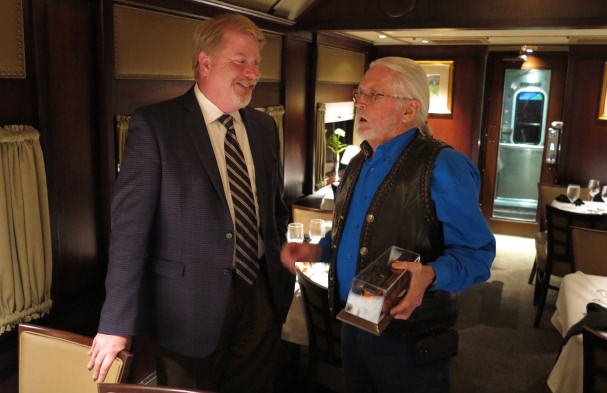
On board a BNSF business car, Andrew Johnsen (L), BNSF Assistant Vice President of Community Affairs, and Jackie McKinney, Mayor of Gallup, New Mexico, celebrate Gallup receiving the BNSF Railway Heritage Community Award.
Holiday Express
Now in its eighth jolly year, the Holiday Express once again honored military personnel and their families in 2015 with stops in Wichita, Kansas; Amarillo, Texas; Colorado Springs, Colorado; Cheyenne, Wyoming; and Lincoln, Nebraska. Over the years, the Holiday Express has delighted over 20,000 military personnel and family members. The BNSF Railway Foundation has awarded approximately $570,000 to local charities that support military families.
BNSF Holiday Express festivities.

Did You Know?
Every holiday season, about 50 million packages are shipped on BNSF. That’s more than 5.5 million packages per reindeer pulling Santa’s sleigh (including Rudolph).
BNSF Railway Foundation
The BNSF Railway Foundation serves as a key vehicle for BNSF to contribute to our local communities. In 2015, the foundation donated more than $10 million to worthy causes in communities along our network through scholarships, sponsorships and funding for community groups.
BNSF Railway Foundation donations in 2015 included:
$100,000
to the Omaha Zoo Foundation
$200,000
to the North Dakota State University Development Foundation
$300,000
to the National Fish and Wildlife Foundation
$500,000
to the Salvation Army DFW Metroplex Command
Tribal Relations
BNSF Railway has strong and deep-rooted relationships with an array of Native American tribes, from the Samish in the Pacific Northwest to the Kickapoo in South Texas. BNSF’s new Tribal Relations team began its first full year of engagement in 2015 and has already met with 43 tribes and launched internal education and processes to help BNSF employees better understand tribal issues. The Tribal Relations team strives to enhance BNSF’s role as a neighbor, an economic partner, and a fellow steward of the environment and tribal culture.
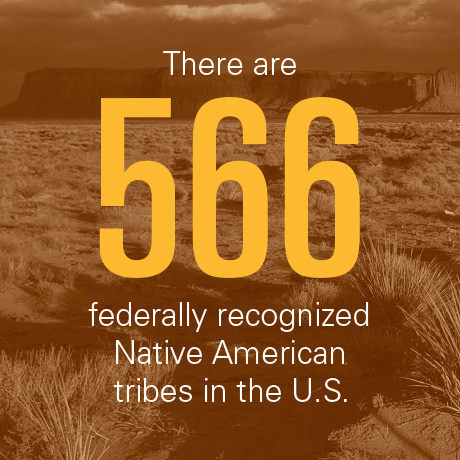
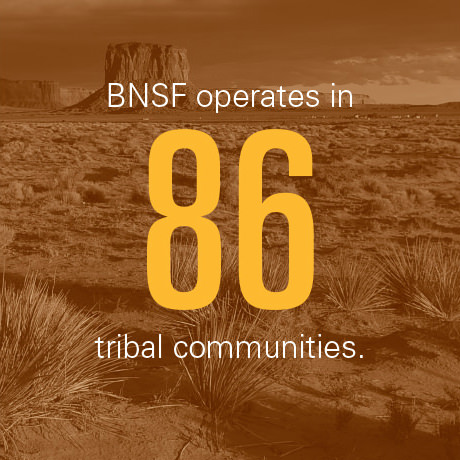
BNSF Railway is a Berkshire Hathaway company.
Berkshire Hathaway and its subsidiaries engage in diverse business activities, including insurance and reinsurance, utilities and energy, freight rail transportation, finance, manufacturing, retailing and services.
